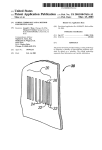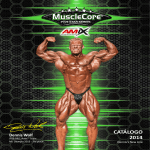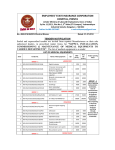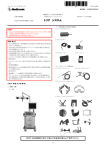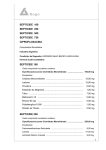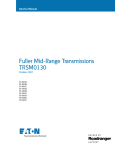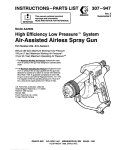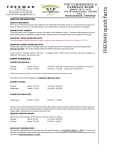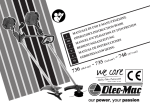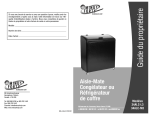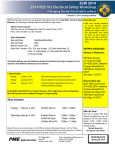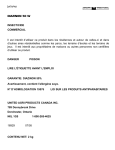Download F|G.l 1
Transcript
Oct. 24, 1961 J. w. CHURCH 3,005,791 FLOORING MATERIALS Filed Sept. 18, 1957 /0\ I ) 6 5 5 /0a 5. / F|G.l 1 ///d . | e Z 9 6 ‘9 ‘9 V//Q' q, q, n 2 v s a, q v o 6‘ ‘,0, L _ °\ o INVENTOR J52?” 6 CV 2'05 BY , 0| . 3 ATTORNEY United 3,005,791 E08 Patented Oct. 24., 1961 l 2 ing action to form homogeneous masses of mixed mate rials. ' 3,005,791 FLOORING MATERIALS John W. Church, Newburgh, N.Y., assignor, by mesne assignments, to The Ruheroid Co., South Bound Brook, The masses are suitably sheeted out in manners well known to the art, such as being further incorporated on a two-roll mill, at which time marbleizing stock may or many not be added; and reducing to desired thickness N.J., a corporation of New Jersey by passing through a train of calender rolls, while being Filed Sept. 18, 1957, Ser. No. 684,706 9 Claims. (Cl. 260-47) maintained at an elevated temperature suitable to produce ductility, and the required adhesion to the calender rolls. The ?nished sheet is partially cooled, and now may be coverings and is herein described as embodied in what 10 cut into sheets or tiles of any required size, or rolled up may be called: into rolls. This is the typical and rather well-known, This invention relates to compositions suitable for floor (1) A grease-resistant asphalt tile, although the tile so-called “Asphalt Tile” process. contains no asphalt, as covered by Federal Speci?cation SS-T-307. In most cases, the original calendered sheet is cut up immediately into tiles, and any ‘border, as well as rejected (2) A vinyl tile conforming to the Type I description 15 tiles, are returned for reprocessing along with the new under L-T-75l. batch. The system is completely thermoplastic, and the In the drawing FIG. 1 is a diagrammatic sketch of product resoftens to workability as soon as its tempera apparatus for carrying out the chlorination of paraf?n; ture is elevated to the desired point. In order that the and FIG. 2 is a top plan View of a mold test transparency ?nished composition may pass the grease-resistant prop— gauge. 20 erties of SS-T-307, as well as the other requirements, the In ?ooring compositions, great resistance is a highly selection of the ingredients used must be carefully made, desirable characteristic. Asphalt tile, as it is now made to conform to Federal Spec?cation SS-T-306b, is not and the processing conditions must also be carefully con trolled. This tile (3.08/1 ratio-P45/vinyl) gave the ‘follow mg test results, when tested in accordance with Federal made so as to be grease resistant. A limited amount of so-called asphalt tile is made to conform to the require ments of grease-resistant tile, Federal Speci?cation SS Speci?cation SS—T-307: T~307. However, special synthetic resins, considerably more costly than those used in the SS-T-306b type, are Sample required, and the cost of the resultant product is so high as to limit its use. Specimen SS-T-307 Requirements 30 There are other forms of ?ooring compounds which are grease resistant, such as the vinyl tiles under Federal Speci?cations L-T-751 and certain linoxin or linoleum One-minute penetration (mils)____ Ten-minute penetration (mils)____ 9. 4 14. 7 6.0 to 15.0. Maximum allowed (mils) _______ __ Indentation at; 115° F. (mils) ____ _- 14.8 32.0 1.4.8. 36.0. types, as well as certain types of vinyl compositions lami Impact __________________________ __ O.K. Shall not crack or nated to felt or other cellulosic backings. All of such De?ection _________ _. __.- >2” Not less than .4”. other products, however, have disadvantages in one form Curl ______________ ._ _-__ . 015 Not greater than .030. break. Oil & Alkali Resistance 1 (Scratch or another, such as: width : (a) High cost. (b) Failure to pass the curling requirements of both such high Wetting power and, at the same time, such ex cellent grease resistance, that it may be combined with relatively large amounts of low-priced ?llers, such as ground limestone, asbestos ?bre and pigmentsv for color, . O55 ___ .125 do____ .130 Not greater than .170 D0. - ' ated cottonseed oil) .1 SS-T~306b and SS-T-307. I have discovered that an economical composition, ‘made conforming to all the desirable characteristics of SS-T-307, may be produced by combining a certain type of chlorinated para?‘in with a certain type of vinyl poly mer or copolymer, to form an organic hinder which has Control _____________ _.Inches_. Lar __________________ __ Wesson Oil (hydrogen- - Kerosene ______________ __do.___ 2% TSP ______________ __do____ d .100 Do. . 055 D0. 9.000 \/ID3x8.992 to 9.008. Sue ----------------------- -~ 9.000 AMDA Thickness (Gauge) ________ __do-___ 3/8” (.125) I .120 to .130. 45 1 Covering both class 1 and class 2 oil and alkali resistance tests. 2 Wesson Oil (hydrogenated cottonseed oil) used as a substitute for cottonseed oil. 3 Machine direction. 4 Against machine direction. The chlorinated para?in, which is not grease resistant so as to give a highly serviceable, curlproof, grease resis 50 in and of itself, is converted into a grease-resistant binder by complete and thorough solution in, and miscibility taut, ?ooring material. with, the vinyl copolymer. If, for any reason, the asso This product may be formed in large sheets, or may ciation is incomplete, or the two do not remain in com— be marketed in the form of tiles of any convenient size. It may also be produced in a variety of thicknesses. A plete miscibility with each other, and if the chlorinated typical composition of such a product is as follows: 55 para?‘in tends to sweat or exude from the gelled mass obtained, then the grease-resistant properties will be EXAMPLE #l.—-GREASE RESISTANT found wanting. ASPHALT TILE P-45 chlorinated parai?n ______________ __v___.. 14.890 Vinyl copoly-mer __________ __>______________ __ Polymerized rosin Stabilizer1 __ vinyl polymers and copolymers in the ranges described .875 60 herein. Only by careful chlorination of the paraf?nic 4.850 .260 Ground limestone _________________________ __ 56.825 7R asbestos ?bre ________________________ m. 19.300 Pigment ‘ __ It should be understood that para?inic materials, in and of themselves, are not miscible nor compatible with 3.000 100.000 1 Such as epoxy resin, barium cadmium laureate, barium ricinoleate, and others. hydrocarbon to at least 45%, may the para?n be ren dered soluble in,’ and permanently miscible with, the vinyl polymer. Furthermore, if the chlorination is car 65 ried out in such a way that either: (a) Portions of the paraf?n are chlorinated to a low degree, even though the average chlorine content may be at the proper level, the chlorinated produce will take on the characteristics of the least chlorinated fraction, The ingredients are placed together in an intensive 70 and, therefore, cause impermanent miscibility, with the resultant loss in grease-resistant properties; or still further, Perkins mixer, and fluxed together by an intensive knead— (b) If the chlorination is not controlled so that prod internal mixer, such as a Banbury mixer or a Baker & 3,005,791 3 .4. ucts of the proper composition are obtained, resulting in decomposition, then also will the product be lacking found to have a color of about 2 on the Barrett scale. When the same material was made, and any local over heating was permitted, or the temperature was allowed to rise substantially above 125° C., the material was dark and, in some cases, almost ink black. This color is one indication of decomposition, and has a marked effect upon the properties of the product. If stored at an elevated temperature over a long period of time, or in merit. A typical method for making the chlorinated para?iin noted above as P45 is as follows: A chlorination apparatus, such as shown in the at tached drawing, is charged with a melted or liquid hydro carbon, at a temperature of 80° C. Dry gaseous chlo rine is closely associated with the entire mass of hydro if hydraulic acid gas is not properly stripped, decomposi carbon by violent agitation of the hydrocarbon and the 10 tion with an attendant darkening in color takes place. However, if it is desired to store the product at a higher temperature, it may be stabilized by the use of the usual chlorine together. The exothermic heat of reaction is removed by suitable cooling methods. Sometimes it is helpful to use ultra-violet light as a catalyst for the re heat stabilizers commonly used in stabilizing polyvinyl action, but this is not absolutely necessary. Chlorina chloride, with or without the accompaniment of alka is continued until a given viscosity, softening point, tion into the flooring batch, chlorinated parai?n, as well by blowing with dry air; by subjecting to vacuum; or by ?ller, then the amount of other stabilizers required is diminished. tion is continued over such time as is necessary, and 15 line earth metals or alkaline earth carbonates. Whether or not the material is stored at elevated temperatures is always with violent agitation, so that each molecule can purely a matter of individual preference and expediency. be conceived to have been subjected to the same degree However, either before or at the time of the incorpora of chlorination as the others in the mass. Chlorination speci?c gravity, or chlorine content is reached. Either 20 as the vinyl polymer, must be stabilized against decom position. The amount of stabilizer to be incorporated or all of these methods of tests may be employed, al depends a great deal upon the composition of the batch though quick tests, such as speci?c gravity or softening itself, and it is a well-known fact that if alkaline earth point, are usually preferred to the longer tests, such as metal carbonates, such as calcium, magnesium, or a com percent chlorine, in controlling the reaction. The re sultant product is now freed from hydrochloric acid gas 25 bination of the two, be used as a large portion of the a combination of the two. The above speci?ed properties of the chlorinated Local overheating is avoided by heat exchange control paraf?n, as Well as the process for making it, may vary during the process so as to circumvent decomposition. Temperatures used may vary over a wide range. Com 30 within quite wide limits. For instance, if the chrage pletion of reaction is a time-temperature function, and the higher the temperature which is used, the higher the rate of chlorination, provided that the temperature does not exceed the point Where decomposition begins. Gen erally, the practical temperature limitations of these ma 35 stock used had been of an average composition of C25H62, the amount of chlorine required to bring it to a melting point of 42° C. would have been less, by about 4%, e.-g., about 54% chlorine, and as a result, the speci?c gravity of the material would have been some tion proceeds, the viscosity increases, so it is desirable what lower. Conversely, had the hydrocarbon charged stock been of the order of C15H32, 42° C. melting point to maintain as high a temperature as possible towards the end of the reaction period, so as to achieve as high would probably not be achievable within the range of practical chlorination. Likewise, 42° C. melting point reaction is ?nished, to as low a temperature as possible pendent upon the type and amount of vinyl polymer with terials are between 80° C. and 125° C. As the chlorina mobility and as high distribution of gas as possible. The 40 is not a speci?c requirement, but either a lower or higher melting point chlorinated product may be used, de product is preferably cooled immediately, as soon as the which it is to be associated, and depending upon the de gree of hardness or softness desired in the ?nished prod and still permit it to be handled. The particular chlorinated paraf?nic material used in the above formula was produced as follows: 45 uct. Vinyl copolymer Crude petroleum wax, of approximately the compo sition C2UH4Z, was melted, brought to a temperature of 80° C., and charged into a glass tank, equipped with a recirculating pump connected by pipe lines to the glass The vinyl copolymer used in the above example ana lyzed to show hydrogen chloride, acetic acid, hydrogen and carbon, corresponding to a composition of 13% vessel. The pump caused the liquid to move at a high 50 vinyl acetate and 87% vinyl chloride. 'A 2% solution velocity to a pipe line, into which dry chlorine gas was in cyclohexanone has a relative viscosity of 2.5, and introduced. Reaction, in part, was almost instantaneous, and the by-product hydrochloric acid gas, along with a relatively small amount of unreacted chlorine, was led should have a mold transparency spread, according to the below method, of 7.05 cm. to 9.0 cm. ‘One method for preparing this type of resin is as follows: over into a second or scrubbing reactor, and the gas from 55 it in turn was led to a third, so that the exit gas was almost entirely hydrochloric acid gas. In order to avoid foaming at certain points during the reaction period, a small amount of a volatile paraf RECIPE Parts by weight Vinvy chloride monomer ___________________ __ 82.1 Vinyl acetate monomer ____________________ __ ‘17.9 Water _ 220.0 ?nic hydrocarbon, having a boiling range of 400° to 60 Lauroyl peroxide 500° F., was introduced into the system, and a re?ux Aerosol OT (sodium dioctyl sulfosuccinate)____ 0.35 0.1 condenser was mounted on the exit of each chamber to Methocel (methyl cellulose) 1500 ___________ __ 0.12 condense any of this somewhat volatile hydrocarbon Carbon tetrachloride _____________ -2‘ ________ __ 1.0 carried off by the hydrochloric acid gas. The action of Trichlorethylene 1 .0 the condensing vapor upon the viscosity of the foam 65 layer, on top of the mass of chlorinating hydrocarbon, Lauroyl peroxide is the catalyst for polymerization. was successful in controlling the foam. Aerosol OT (sodium dioctyl sulfosuccinate) and Metho The temperature was allowed to rise to an average cel 1500 are emulsifying and suspending agents respec point of about 110° C., and was never allowed to exceed tively. Carbon tetrachloride and trichlorethylene are 125° C. by control of the exothermic heat generated. 70 “chain stoppers,” by means of which the molecular weight of the product is controlled. The reaction was continued for 30 hours, at the end of which time analysis revealed that the chlorine content Method of procedure was 58%; the ASTM ring and ball softening point was 42° C.; and the speci?c gravity was 1.38. The material Vinyl chloride monomer is ?rst freedilfrom any in was immediately cooled to room temperature, and was 75 hibitor (phenol or substituted phenol), by washing with 3,005,791 . 5 caustic soda. It is then dried to 'free it from any caustic should be not less than 15° C., or more than 55° C., soda or sodium phenolate, preferably by distillation. The water, lauroyl peroxide, Aerosol OT, Methocel 1500, carbon tetrachloride, trichlorethylene and vinyl and that the percent binder in the ?nished composition should be within the limits of 18.5% and 25% to produce tile to conform to Federal Speci?cation SS-T-307, al acetate monomer are previously co-incorporated in an 5 though there are possible an almost in?nite number of agitated charging tank. They are then transferred to an agitated glass-lined autoclave. The air space in the re- combinations of charge stock; degree of chlorination; ' melting point of chlorinated paraf?n; ratio of vinyl resin actor is purged, and the vinyl chloride monomer introto chlorinated para?’in, of binder to ?ller, etc. duced under pressure, vfrom a “weigh by di?erence” The properties of the vinyl polymer to be used may pressurized weigh tank. Agitation is started and- the 10 be vdetermined principally by the following tests, within temperature is gradually raised to 55° C. by means of the limitations shown: a hot-water charging jacket on the autoclave.. Pressure I0 . . . . . an aren test_--_. Method f Test #16, at this point builds up to slightly over 100 p.s.i. Reaction (a) N Id H p Cy attachgd =18 maintained at_this pressure until complete, as indi- cated by the falling pressure. (b) Relative viscosity_______ __ Method of Test #174, When a pressure of 16 15 attached p.s.i. is reached, the reaction is terminated and the time ‘ required is 9 to 10 hours, The vessel is vented and the liquid charge dropped into a receiving tank. ' _ . An additional example of the number of variations ‘ll/111101} may be Practlced Wllhl? lhe 500W Of my Inven The product is now dewatered and U011 ‘18 as follows! rinsed in a centrifuge, and dried at low temperature to 20 EXAMPLE #.H__TILE, VINYL TYPE I produce a ?ne white powder. _ The form of vinyl polymer is that of a rather ?nely comminuted powder. In order to obtain the particular properties desired in this particular instance, a ratio of _ Pami?m°_l_1YdI°°arb°n,_°f appmmmahely C2°H42 av?“ age composition, was continuously__chloririated to a chlo nnePGment _o‘f 525%; had a melting Pom‘ of 15 C‘; a 3.08 parts of the chlorinated hydrocarbon per part of 25 specl?c gravlty of 1257; and a color of one (1) on the vinyl polymer was used, and at this dilution of the vinyl Barrett Scale‘ resin, it is extremely important that substantially all of . _ a _ The, average temperature of chlonna_tlon W3? 100 C" it vbe dissolved in, and be permanently and completely Smce It was nf’t necessary to go‘ tP'_qmte ‘as hlgh 3' tam" co-nn'scible with the chlorinated paraffin. Therefore, it Pam/Lure m _thls _case as m the (mgmal case’ be‘fause ‘if is frequently desirable to associate the resin and the 30 ‘the lower 'vlscoslty‘ The ?mshed Product was Immedl‘ chlorinated hydrocarbon together, prior to incorporation atialy degassed’ "md_ ch?ied ‘to room temperature- with the rest of the ?ooring composition batch. This will depend, however, upon the time, temperature and degree of l'l'llXlIlg employed in the mixing of the tile batch, and is 'thls ‘case’ ‘the followmg me formula was used: Chlorinated Paraffin #2 __________________ __ vinyl copolymer #2 _____________________ __ 11340 7900 not a pre-requisite, unless it be desired that the time of 35 pdlymerized msin _______________________ __ mixing of the ultimate batch be short. Although -I mention the particular way in which the In _875 Stabilizer 1 _____________________________ __ Ground limestone _______________________ __ _260 46125 resin in this particular case was made, and its particular 7R Asbestos Fibre, ___________ __-_ _________ __ 30,009 characteristics, there are other recipes and procedures Pigment 3,000 which may be used, within the scope of my limitations, 40 __. to give the desired result; for instance, instead of the 100900 polymel‘lwlm ‘taking place m ‘Yaw; Suspenslon: it cougd be done in the presence of a liquid hydrocarbon, such as described in the ‘US. Patents Nos. 2,064,565 and 1 Such as epoxy resin, barium cadmium laureate, barium ricinoleate,a11d Others This tile gave the following test results when tested in 2,075,429. The ratio of chlorinated para?in to vinyl poly- 45 accordance with Federal Speci?cation SS-T-307, and mer selected for this particular case is not rigid, and I with Federal Speci?cation L-T-751 (Tile, Floor, Vinyl have determined that ratios between 1.5 to 1, and 4 to 1, Plastic); ' l/é" Sample SS-T-307 Requirements Specimen Onelrninute penetration (mils)-. 10. 5 6 0 to 15 0 _______________ -_ Ten-minute penetration (mils). 13. 5 __________________________ .. Maximum allowed (mils). . .-. . Indentation at 115° F. (mils) ___________ .- 15. 6 22. 5 15.6... 36.0 _____________________ .. Residual Indentation. ._ _ 346” Sample Specimen L-T-751 Requirements 7.0 to 15.0. 14.2. 35.0. __- T‘mnant 0,K. De?ection (Flexibility) _________________ -. 2" 5% Average. Shall not crack or break... Shall not crack or break. Not less than .4” ........ .- 3% Dimensional Stability Not less than .6”. Less than .012”-..- Nat more than .015/lin. Curl ................................... .- Volatile materiaL- .015 Not greater than .030 .... .. - .010 ......... ..--..- Not greater than .030. Less than 1% .... .- Not greater 1.0%. Oil _ (331g Alkali Resistance (Scratch W1 1 Control .................... .-llnches-- .055 Not more than .17 ” .... .. .055 ............. .. . Not more than .120”. Lard ......................... -_do_--. . 080 do .055. _ . Wesson Oil (hydrogenated cot- do--.tonseed oil). .105 ..-..do .060... Do. Do. Kerosene ..................... ..do.... .115 ...._do .070... Do. 2% Trisodinm phosphate 50- do-.-. .100 -...-do lution. 5% NaOH . ' ' Not more than .120”. Ethyl Alcohol- . ..--. Do. Motor 0" 5% Soap Size .............................. .-do Do. - Thickness (Gauge) ............... .-do---- ...- .. 9”x9” 8.992 to 9.008 ............ .. .125 are practical to give the product within the scope of my claims. Speci?cally, I ?nd that chlorinated para?in should contain not less than 45% chlorine, nor more .120 to .130 .............. .. . 75 . Do. 5101125" . $0.005” Vinyl Polymer #2 consisted of ten parts of vinyl ace~ tate and 90 parts of vinyl chloride, which were dissolved in normal hexane under pressure in the presence of 3% lauroyl peroxide, and polymerized under agitation at a than 60%; that the charge stock shall preferably be in the range of C18H38 to CmHGZ; that the melting point 75 pressure of 100 pounds per square inch, at a temperature 3,005,791 8 27 (2) Cover the vinyl copolymer with another sheet of of 50° C., with stringent agitation, in accordance with U.S. Patent No. 2,064,565. The resultant polymer had Te?on and a 59716” x 5%6” x 1/2" aluminum cover plate. (3) The sandwich of the two aluminum plates, the a composition of approximately 90% chloride and 10% acetate, and gave the following test results: two Te?on sheets, and the vinyl copolymer comprise the mold assembly. (a) Mold transparency test ____ __ 4.59 cm. (4) A Carver Laboratory Press, described as attached hereto, is heated electrically to 155° C. with the platens (b) Relative viscosity __________ _. 3.07 (2% solution). Conclusions in contact with each other so as to assure uniform heat The use of chlorinated paraffin in vinyl compositions ing of both plates. When the temperature has risen to is not new. However, its use in the proportions cited herein is distinctly new and novel. The recommenda tions of the commercial manufacturers of chlorinated para?in all warn against its use in a greater quantity than and the mold assembly inserted.‘ (5) The press is then closed to contact pressure only and held for one minute. 155° C., the electricity is turned off; the press opened; (6) Pressure is raised to 2000 lbs./ sq. in. on the outer 25% of the plasticizer content. The conventional prod uct of commerce is 40% chlorinated para?in, and when 15 scale, which reads the pounds per square inch on the 36 this product is used in any of the portions cited above, it does not make a homogeneous, permanently miscible combination; the chlorinated paraf?n either failing to completely ?ux the vinyl resin in the ?rst part, or exuding or sweating out of it upon cooling. Its use in vinyl com sq. in. platen. (7) Release pressure and transfer to water-cooled cold press at 2000 lbs. per square inch pressure for two 20 positions is recommended with strong solvent power plasticizers, such as the di-octyl alcohol ester of phthalic acid. This high solvent power plasticizer (D.O.P.) acts minutes. (8) Release cold press pressure and remove vinyl ?lm from mold. (9) Measure the “Diametric Degree of Transpar ency”1 with the Transparency Gauge2 by placing the molded ?lm on the gauge and reading the highest visible as a coupler between the low solvent power 40% chlori or fraction thereof through the ?lm at each of nated para?in, and vinyl resin, when it is there to at least 25 number the numbered bisecting lines. The “Diametric Degree of three parts DOP to one part chlorinated paraf?n. When Transparency” is the average transparency obtained from these portions are exceeded, and particularly when the the eight readings of the transparency gauge. currently commercial chlorinated paraffin is used along Tolerance as the entire plast-icizer component, the above-mentioned undesirable phenomena occurred. A. INDIVIDUAL SHIPMENTS OF VINYL COPOLYMER In FIG. 1 there is diagrammatically illustrated appara Two moldings shall be made from each individual ship tus for carrying out the para?in chlorination. In FIG. 1, ment of vinyl copolymer under the above controlled con numeral 1 designates a reservoir of para?inic hydrocar ditions, and eight transparency readings for each mold bon and % or partially chlorinated hydrocarbon. Numer ing shall be averaged. If the average numerical reading al v1a designates a gas liquid separation zone of said 35 of the two moldings show a deviationof greater than reservoir. Numeral 2 designates a circulating pump. :2% from one another, other moldings shall be made Numeral 3 designates a chlorine supply. Numeral 4 until two show no greater deviation than i2%. The ir designates a heat exchanger. Numeral 5 designates a re?ux condenser. Numeral 6 designates the spent gas 40 relevant data is discarded. CARVER LABORATORY PRESS ef?ux. ’ In the drawing there is shown two similar units 10, Manufacturer and supplier: 10a. The spent gas ef?ux 6 of unit 10 is connected to Fred S. Carver, Inc. pump 2 of the second unit. The second unit 1011 acts One Chatam Road as a scrubber to remove chlorine from the spent gas Summit, New Jersey e?luent from the ?rst unit 10. Additional scrubbing 45 U.S.A. units may be placed in series if desired. When chlorina Description of apparatus and operation tion has been completed in unit 10 the product is removed and the vessel 1 recharged with hydrocarbon. Raw chlo See Service Manual and General Instructions supplied rine may be introduced into unit 10a and then unit 10 50 by manufacturer. becomes a scrubbing unit. The Carver Laboratory Press is supplied without the heating and cooling accessories. These items are ordered Molding zest: Transparency separately. The press proper has 6-inch square pressing The area of transparency of a molded unplasticized ' faces between which a pressure of 20,000 lbs. can be vinyl copolymer, as calculated from a transparency gauge easily generated by the hydraulic pump handle. The 55 15 (see FIG. 2), is a means of measurement devised to press is self-contained having its own oil pump, reservoir compare the ?ow or thermoplastic properties of the vinyl and gauge. copolymer, and to obtain an indirect qualitative measure Hot Plates (platens), Electric, for use with the Carver ment of the processing behavior of the vinyl copolymer in a given vinyl-asbestos tile formulation. Laboratory Press-These platens are intended for plas tic molding and hot pressing of various kinds. They Apparatus are 6 inches square and are built to operate from a lamp l Carver “Hot” molding press (see attached description) socket. They provide any heat desired up to 204° C. Each platen is equipped with a thermometer well into 1 Carver “Cold” molding press (see attached description) 2 Te?on .014 gauge sheets, 6" x 6". 2 Aluminum plates, 5056" x 5%6” x 1/2" which a thermometer can be inserted in order to deter 65 mine the temperatures. The platens are supplied with thermoswitch, on-oft‘ switch, cord and plug, but without thermometer. The platens are supplied in either 115 l Transparency gauge 1 Stopwatch volt A.C. or D.C., or 230 volt A.C. or DC. 1 Torsion balance Procedure 70 (1) Weigh out 10 grams of the vinyl copolymer to be tested, and place in a small pile approximately 5 cm. in 1Diametric degree of transparency: Since the chart is spaced in 1/1 cm. divisions, the direct reading gives a num bei- twice that of the radial distance in cm. or the diametric va ue. 2‘Transparency gauge: A calibrated chart consisting of ten concentric circles spaced 0.5 centimeter apart and d1 vided into eight equal sections, by eight radial lines spaced diameter on a .014 gauge 6" x 6" piece of Te?on (or equivalent type of coated fabric), which is supported by a ?at 55716" x 50%" x 1/2" aluminum plate. Two 75 5° apart. Each circle is numbered from the center out along each radial line for ease of measurement. 3,005,791 . 9 10 , 6" x 6" x 5A@" Transite boards and two steel wire mesh screens are supplied with the heat' platens to separate and insulate them from the main frame of the press. suction and in pipetting cyolohexanone and test solutions. Take great care to keep pipettes and solution ?asks scru pulously clean and ?lter all eyclohexanone and resin test The cold press platens with provision for water-cooling may be obtained from the .supplier. solutions through a clean fritter disc ?lter as viscosity measurements ‘are very sensitive to contaminants and RELATIVE VISCOSITY adequate, the pipettes and ?asks (may be cleaned readily The relative viscosity ?gure gives a means of compar ing one resin with another. It provides a relative indi dirty equipment. If the regular cleaning procedure is not in boiling cyolohexanone. _ Having thus described certain embodiments of the 1n cation of the average molecular weight of the resin, the 10 vention, what is claimed is: 1. A grease resistant floor tile composed of (a) be “hardness,” or the softening temperature. All these val tween about 18.5% and 25% of a solvent-soluble or~ ues increase with increasing relative viscosity. ganic binder consisting essentially of (1) a chlorinated para?in containing between about 45% and 60% of chlo (a) Ostwald~Fenske Pipette Viscometer, size 100, Fisher 15 rine and having a melting point of about 15° C. to 55° C., and (2) a copolymer of about 87% to 90% vinyl chlo Cat. No. 13-616. ride and 13% to 10% vinyl acetate, in the proportions (b) Fisher Unitized Kinematic Viscosity Bath, Fisher Cat. of from about 1.5 to 4 parts by weight of the chlorinated No. 13-619-1. para?in to 1 part by weight of the copolymer; and (b) (c) Water Bath Clamp, Fisher Cat. No. 15—445-80. (d) 50 ml. Erlenmeyer Flask with glass stopper, Fisher 20 between about 81.5% and 75% of inorganic ?llers. 2. A grease-resistant floor tile as de?ned in claim 1, Cat. No. l0—098. in which the organic binder consists essentially of about (e) Stop watch. 3 parts of (1) a chlorinated parat?n containing between (f) Analytical balance. about 54% and 5 8% chlorine and having a melting point (g) Torsion balance. 25 of around 42° C., and (2) about 1 part of a copolymer (h) 50 ml. beaker. of about 87% vinyl chloride and 13% vinyl acetate. (i) Fritter disk ?ltering funnel, Fisher Cat. No. 10-359— 3. A grease-resistant ?oor tile as de?ned in claim 1, M50. in which the organic binder consists essentially of (1) (j) Mechanical Shaker, Will Corp. Cat No. 23775T. (k) Suction bulb with tube cork assembly for ?lling 30 about 60% of a chlorinated para?in of around 52.5% chlorine and having a melting point of around 15 ° C., pipette. and (2) about 40% of a copolymer of about 90% vinyl (l) Acetone washed ?lter paper (coarse). chloride and 10% vinyl acetate. Procedure and calculations 4. A grease-resistant ?oor tile as de?ned in claim 1, Weigh a 1.0 gram sample of the vinyl copolymer resin 35 in which the inorganic ?llers are mainly calcium carbonate Apparatus to the nearest 0.5 milligram on a tared paper analytical balance. Transfer the sample to a 50 cc. glass stoppered Erlen meyer ?ask and weigh the ‘?ask plus resin on a torsion balance. Add 15 cc. of cyclohexanone slowly and gently 40 swirling to prevent gel formation. Add cyclohexanone to bring the total cyclohexanone to 49 grams. Place on the mechanical shaker for 6 hours or until the resin is completely dissolved (undissolved gel particles can be admixed with asbestos. 5. A grease-resistant ?oor tile as de?ned in claim 1, made of the following ingredients in approximately the following proportions: Chlorinated para?in ____________________ __ Vinyl copolymer ________________________ __ Polymerized rosin _______________________ __ Stabilizer Ground limestone _______________________ _._ detected when the ?ask is held up to a strong light). Remove the ?ask, ?lter the 2% solution through the ace 4.5 Asbestos ?ber Pigment _______________________________ .__ tone washed ?lter paper. 14.890 4.850 .875 .260 56.825 19.300 3.000 Determination of relative viscosity 100.000 Invert the small capillary tube of the Ostwald pipette 50 6. grease-resistant floor tile as de?ned in claim 1 into the ?ltered test solution and by means of the suc contamrng the following ingredients in approximately tion bulb assembly ?ll the tube to the calibration mark the ‘following proportions: nearest to the large reservoir bulb of the pipette. Place the ?lled Ostwald pipette in an upright position in a 25° Chlorinated para?in _____________________ __ C. water bath, using care to insure that the capillary tube 55 Vinyl copolymer ________________ __-_ _____ __ is vertical; the pipette is immersed above the upper cali Polymerized rosin ______ __.___' ________ _‘_____ bration mark; and the bath temperature is correct within Stabilizer 0.1° C. Ground limestone _______________________ _.. Allow test solution to stand in pipette for at least 10 Asbestos ?ber minutes to reach equilibrium temperature. Suck the sol 60 Pigment _ vent into the small bulb above the capillary. Release ( 11.840 7.900 .875 .260 46.125 30.000 3.000 the suction, and measure the time elapsed required for 100.000 passage of the meniscus between the two calibration marks with a stop watch. Repeat the measurement until 7. A grease-proof composition adapted for use in at least two checks (:5 seconds) are obtained. 65 making grease-resistant ?oor tile consisting essentially of After each sample is run, the pipette should be cleaned ( 1) a chlorinated paraf?n containing between about 45% and 60% of chlorine and having a melting point of about 15° to 55° C., and (2) a copolymer of vinyl chloride and The relative viscosity is computed as follows: vinyl acetate in the proportions of about 87% to 90% 70 vinyl chloride and 13% to 10% vinyl acetate, in the Relatl VG VlSCOSlty Solution efflux time proportions of about 1.5 to 4 parts by weight of the chlorinated para?in to 1 part by weight of the copolymer. 8. A grease-proof composition as de?ned in claim 7 Precautions consisting essentially of ( 1) a chlorinated para?‘in con A vacuum line or syringe bulb should be used for 75 taining between about 54% and 58% of chlorine and by rinsing with acetone, blowing with air, and drying at 80° C. ‘for 10 minutes. 3,005,791 11 12 having amelting point around 42° C., and (2) a copoly References Cited in the ?le of this patent UNITED STATES PATENTS mer of about 87% vinyl chloride and 13% vinyl acetate, in the proportions of about 3 parts by Weight of the chlorinated para?in to 1 part by weight of the copolymer. 9. A grease-proof composition as de?ned in claim 7, 5 consisting essentially of (1) a chlorinated paraffin con- " taining about 52.5% of chlorine and having a melting point of around 15° C., and (2) a copolymer'of about 90% vinyl chloride and 10% vinyl acetate, in the propor tions of about 60% of the chlorinated para?‘in to 40% 10 of the copolymer. 2,421,409 2,428,282 7 2,43 6,216 2,45 3,05 2 2,563,593 Brookman et a1 _________ __ June 3, Kemmler ____________ __ Sept. 30, ‘Leatherman __________ _._ Feb. 17, Van Etten ____________ __ Nov. 2, Engel ________________ __ Aug. 7, 1947 1947 1948 1948 1951 FOREIGN PATENTS - 611,300 713,905 Great Britain _________ __ Oct. 27, 1948 Great Britain ________ __ Aug. 18, 1954 UNITED STATES PATENT OFFICE CERTIFICATION OF CORRECTION Patent No, 3,005?9l I‘ October 247 1961 John W, Church It is vhereby certifiedv that error eppears in the above numbered pat ent requiring correctionand that the said Letters Patent should read as corrected below. Column 2v line 68Y for "produce" read -- product —-; column 4, line 9, for "hydraulic" reed -—- hydrochloric -—; line 32, for "C25H62" read -— 025E152 »:—-; line 5?, for "Vinvy"' read —~ Vinyl —-—; column '17 line ‘53:5, for "and‘% or" read -- and/or --; an column 9‘, line 36w after "paper" insert —- on —-., Signed and sealed this 10th day of April 1962, (SEAL) Attest: ERNEST W. SWIDER Attesting Officer 'DAVID L. LADD _ Commissioner of Patents










